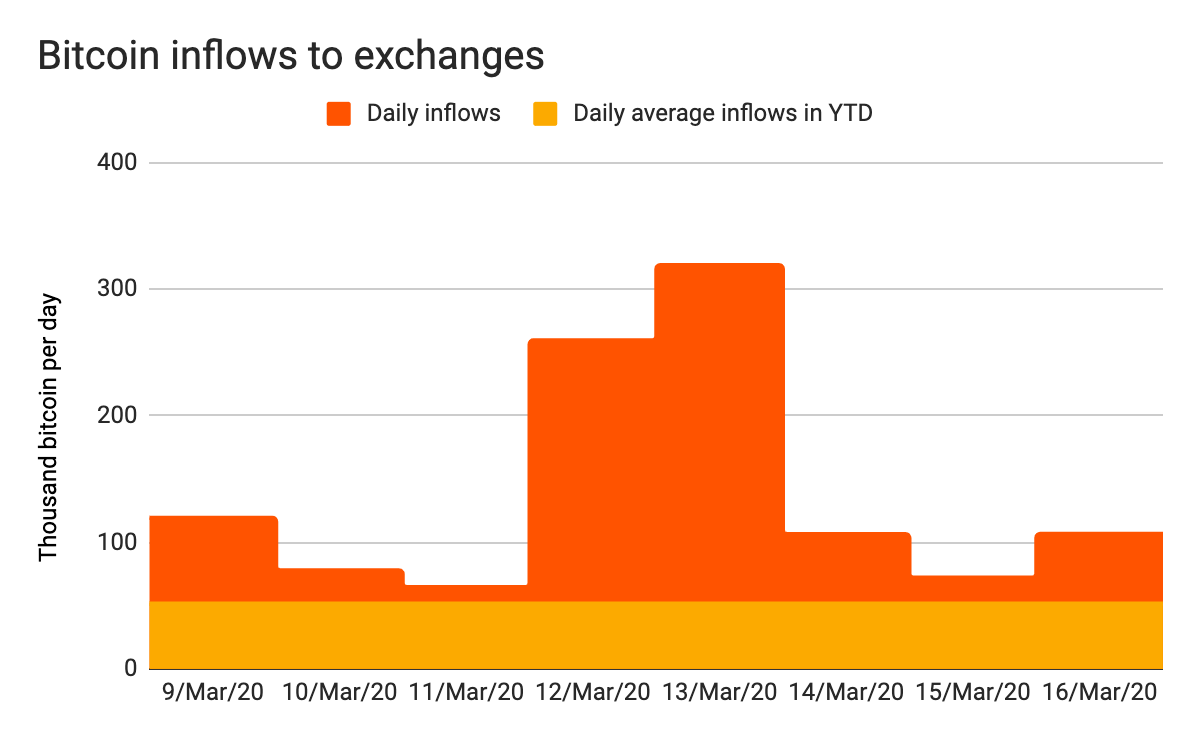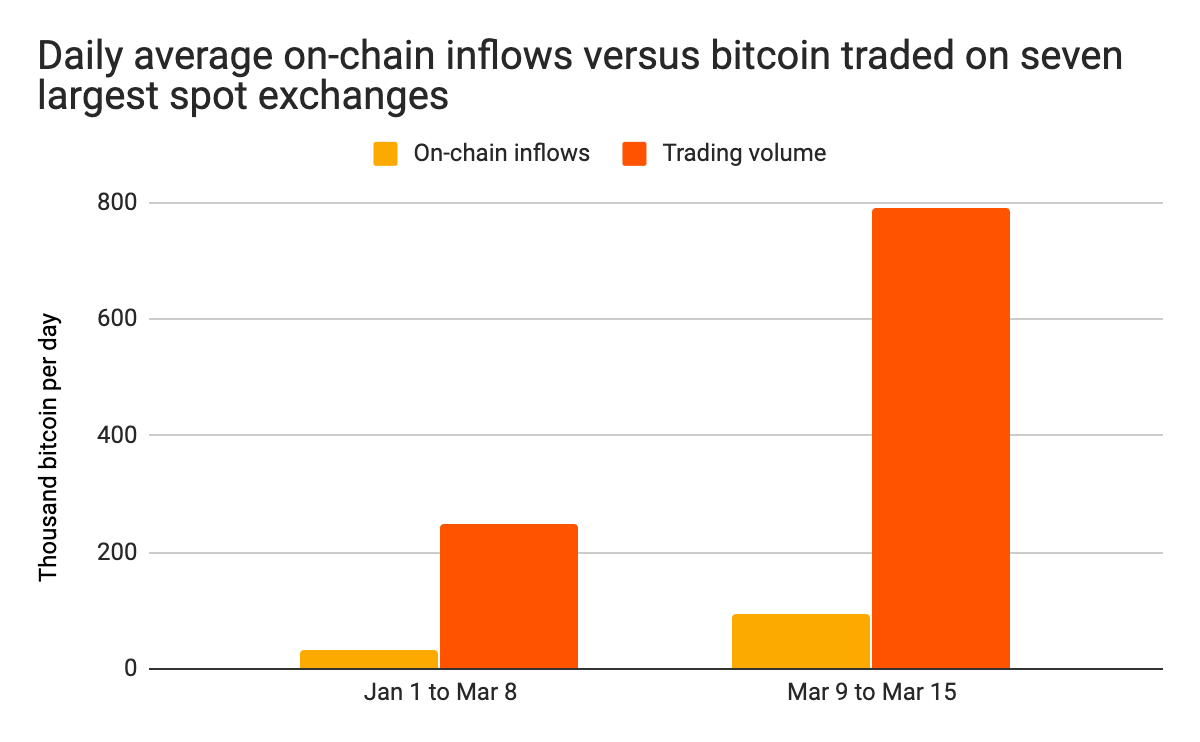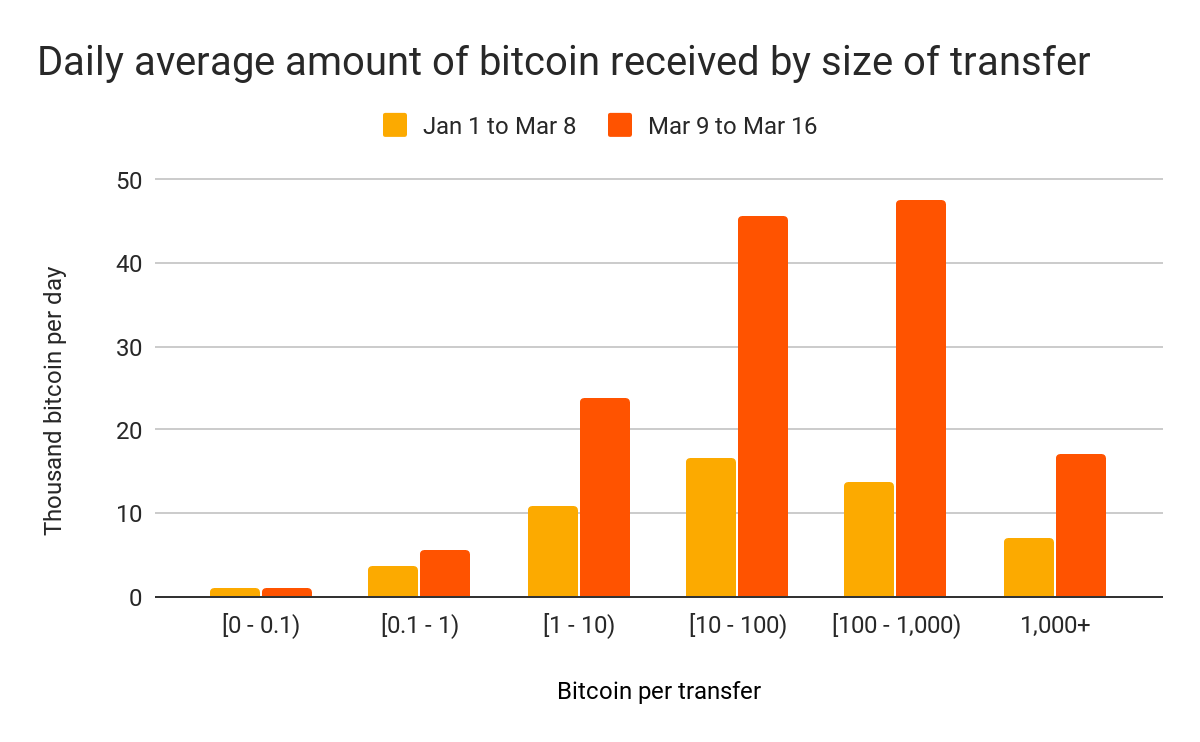Executive summary: The story so far

- Cryptocurrency exchanges experienced their largest ever bitcoin inflows. Since March 9, exchanges received a total of 1.1 million bitcoin over eight days, peaking at 319,000 bitcoin on March 13, compared to an average of 52,000 bitcoin per day prior to March 9 since the start of the year.
- 9x the daily average amount of bitcoin was sent to exchanges to be sold from March 12 to March 13. This selling pressure led to a ~37% fall in price.
- Price pressures have now eased. At least two thirds, if not more, of this extra bitcoin has already been moved off exchanges and daily inflows to exchanges are now just twice the average. Following this, the bitcoin price has stabilized.
- Professional traders and investors were responsible for the majority of the activity. The amount of bitcoin that moved in and out of exchanges by small transfers – between 0.1 and 10 bitcoin – almost doubled since March 9. This suggests that there was significant ‘retail’ involvement in both selling and buying. However, transfers of between 10 and 1,000 bitcoin were responsible for 70% of the bitcoin in and out of exchanges.
- The majority of available bitcoin was not cashed out, suggesting that most bitcoiners are happy to hold. At 712,000 more than average, the amount of bitcoin sent to exchanges in the last eight days is unprecedented. But this extra 712,000 represents just 5% of available bitcoin (all mined bitcoin minus all lost bitcoin).
An unprecedented increase in sell pressure that may be easing off
Exchanges faced an unprecedented increase in people looking to sell bitcoin, starting on March 9 but peaking on March 12 and March 13. Exchanges received roughly 475,000 more bitcoin than average over March 12 and March 13, representing a 9x increase. Since then, inflows have dropped to just twice the average.

Exchanges received 52,000 bitcoin per day on average from January 1 to March 8, 2020. From March 9 to March 16, they received 1.1 million bitcoin over 8 days, or 712,000 more than average. Of that 712,000 bitcoin, between 40,000 and 240,000 remain on exchanges, meaning that only between 6 and 34% of the extra inflow has either yet to be sold or has been sold but could easily be sold again by the new owners. In other words, the majority of excess bitcoin arriving at exchanges has been sold, and the worst of the oversupply appears to be finished for now.
Trading activity jumped significantly as bitcoin flowing into exchanges was sold. The activity was relatively concentrated, as just seven spot exchanges received nearly two thirds of the increased inflows. Prior to March 9, those seven exchanges had 249,000 bitcoin traded per day on their platforms across all trading pairs, according to Kaiko. Since March 9, that average jumped to 790,000 bitcoin traded per day. But due to the accompanying increased on-chain inflows, these exchanges saw a jump of just 0.9 bitcoin traded for every bitcoin received on-chain, from 7.6 earlier in the year to 8.5 in recent days.

The increased trading on these seven exchanges was largely matched by their increased inflows, which suggests that trading was driven primarily by new bitcoin entering exchanges, rather than bitcoin already held on exchanges. If bitcoin already on exchanges was traded more in recent days, we would expect the ratio of bitcoin traded to bitcoin received on-chain to be higher.
Furthermore, while the market has struggled to absorb the extra bitcoin being sold, that extra amount represents a small portion of all available bitcoin, suggesting that the majority of bitcoin holders remain happy to hold.
The extra 712,000 bitcoin that came to exchanges represents just 5% of the 14.52 million available bitcoin (we calculate available bitcoin by subtracting the 3.75 million lost bitcoin from the 18.27 million total bitcoin mined). Exchanges hold around 4 million of the 14.52 million bitcoin (our lower bound estimate is 2 million and the upper is 5.5 million). As we describe above, while some of this will have been recently traded, it does not appear to have been excessively traded and exchange balances have increased. But even if we made the extreme, nearly impossible assumption that all 4 million bitcoin held on exchanges was sold, there are at least 9.8 million bitcoin — 67% of all available bitcoin — that didn’t “head for the exit.”
Who sold?
We’ll have more insight into who sold most in the coming days, but our initial findings show that while retail-level activity increased substantially, professional traders drove most of the increased exchange inflows. The amount of bitcoin that moved in and out of exchanges by small transfers — between 0.1 and 10 bitcoin — almost doubled since March 9. This suggests that there was significant ‘retail’ involvement in both selling and buying.

However, the majority of bitcoin flowing into exchanges came from high-value transfers, as is normally the case. In particular, transfers of 10-100 and 100-1,000 bitcoin were in total responsible for around 70% of all bitcoin sent and received by exchanges in recent days, a similar but slightly higher share than usual. Around 10% of bitcoin was from transfers of over 1,000 bitcoin.
These trends suggest that the deeper pocketed professional traders and investors were driving the market, but they were joined, both on the selling and the buying, by a large number of retail holders.
Given the uncertainty around the COVID-19 pandemic, it’s hard to predict where the bitcoin market will go next. However, large increases in exchange inflows have proven to be a good indicator of increased volatility, so we recommend keeping an eye on the amount being transferred to exchanges. We also expect that professional traders will continue to drive events, as opposed to retail exchange users, simply because they are responsible for much larger volumes.
Want to learn more about how on-chain data can help us understand trends in cryptocurrency markets? Download our report on Market Events!
